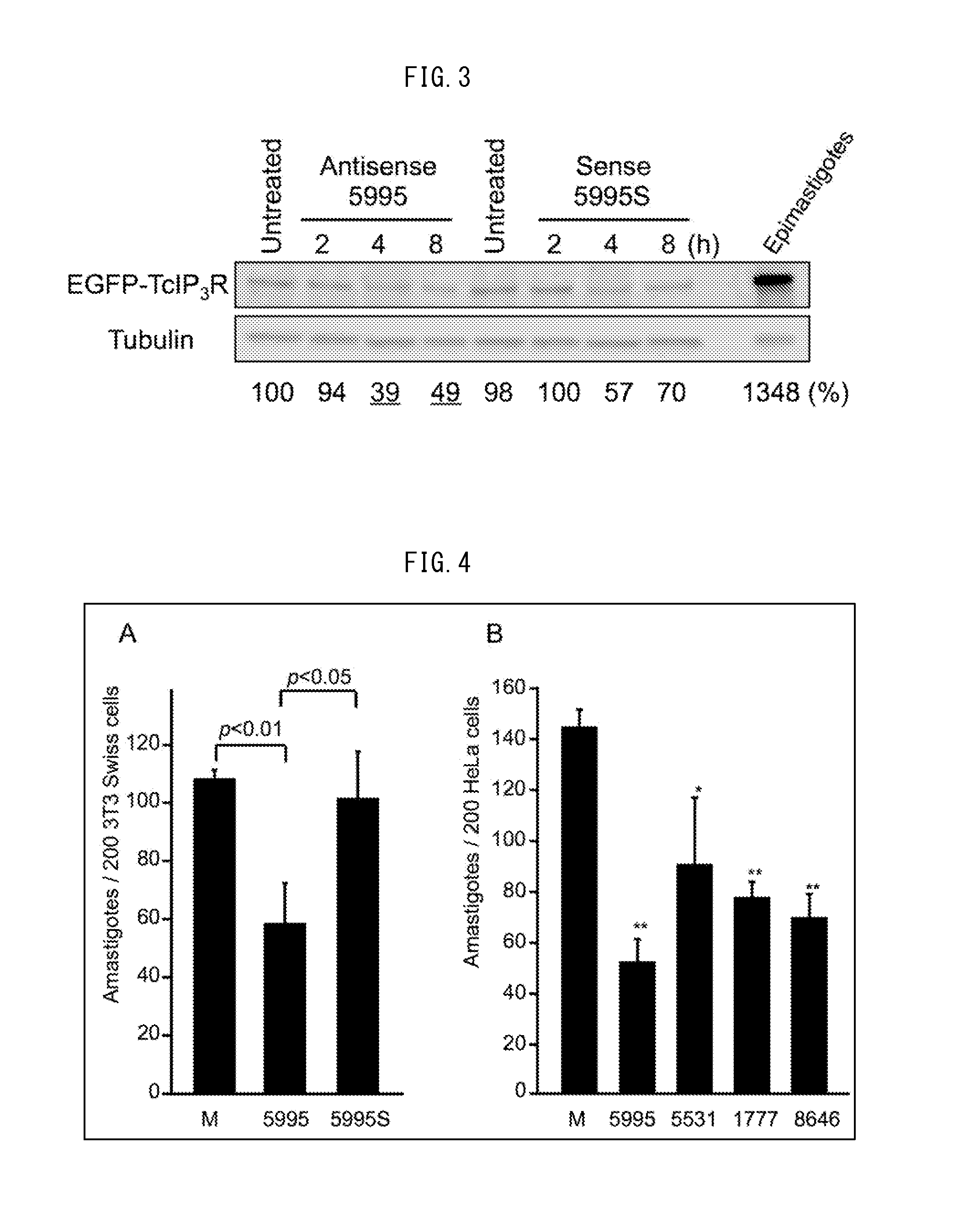Therapeutic agent for treating trypanosoma-associated disease, method for killing trypanosoma parasites, and use thereof
- Summary
- Abstract
- Description
- Claims
- Application Information
AI Technical Summary
Benefits of technology
Problems solved by technology
Method used
Image
Examples
reference example 1
Determination of Property of TcIP3R Protein
[0106]The antisense oligonucleotide inhibits expression of a protein by inhibiting transcription of mRNA or translation of polypeptide or destabilizing mRNA, or peptide synthesis. As such, a short-lived protein is a desirable subject of an effective and functional knockdown by the antisense oligonucleotide. In order to check whether or not the TcIP3R is suitable for a strategy of the antisense oligonucleotide, epimastigotes of T. cruzi were cultured in the presence of Cycloheximide (CHX), which is a protein synthesis inhibiting agent, and degradation of the TcIP3R protein was observed over time by western blotting.
[0107]Results are shown in A of FIG. 1. FIG. 1 is a view showing a life span of the TcIP3R protein in epimastigotes of T. cruzi. A of FIG. 1 is a view showing an expression level of a native TcIP3R protein in epimastigotes. B of FIG. 1 is a view showing an expression level of a recombinant EGFP-TcIP3R fusion protein. Epimastigotes...
reference example 2
TcIP3R Protein Level in Trypomastigotes
[0111]The inventors of the present invention showed that transcription of mRNA of TcIP3R constantly occurs through a life cycle of T. cruzi, and a transcriptional level differs depending on a form of the T. cruzi and is the lowest in trypomastigotes. In the present Reference Example, western blotting using an anti-TcIP3R monoclonal antibody was carried out to examine how an expression level of the TcIP3R protein differs depending on a developmental stage. As an internal control, western blotting was carried out with use of an antitubulin antibody. Results are shown in FIG. 2. As shown in FIG. 2, the TcIP3R protein is detected in epimastigotes (E) but not detected in trypomastigotes (T). The results suggest that a level of the TcIP3R protein in trypomastigotes is very low. This result shows that the antisense oligonucleotide exerts an action more effectively in a case where the antisense oligonucleotide targets the trypomastigote form, which is ...
example 1
Suppression of TcIP3R Protein Expression Using TcIP3R-Specific Antisense Oligonucleotide
[0113]Evaluation was made as to whether or not a treatment using a TcIP3R-specific antisense oligonucleotide can actually prevent TcIP3R protein expression in trypomastigotes. Since no TcIP3R protein was detected in a trypomastigotes (see B of FIG. 1), trypomastigotes which over-express EGFP-TcIP3R were cultured in the presence of an antisense oligonucleotide (SEQ ID NO: 3: Antisense 5995) or a sense oligonucleotide (SEQ ID NO: 7: Sense 5995S), and western blotting was carried out with use of an anti-EGFP antibody. As an expression control of EGFP-TcIP3R, untreated epimastigotes which over-express EGFP-TcIP3R were used. As an internal control, western blotting was carried out with use of an antitubulin antibody. Results are shown in FIG. 3.
[0114]Also in T. cruzi which over-express EGFP-TcIP3R, a significant decline was observed in EGFP-TcIP3R protein expression level in trypomastigotes. This show...
PUM
| Property | Measurement | Unit |
|---|---|---|
| Fraction | aaaaa | aaaaa |
| Concentration | aaaaa | aaaaa |
Abstract
Description
Claims
Application Information
 Login to View More
Login to View More - R&D
- Intellectual Property
- Life Sciences
- Materials
- Tech Scout
- Unparalleled Data Quality
- Higher Quality Content
- 60% Fewer Hallucinations
Browse by: Latest US Patents, China's latest patents, Technical Efficacy Thesaurus, Application Domain, Technology Topic, Popular Technical Reports.
© 2025 PatSnap. All rights reserved.Legal|Privacy policy|Modern Slavery Act Transparency Statement|Sitemap|About US| Contact US: help@patsnap.com


